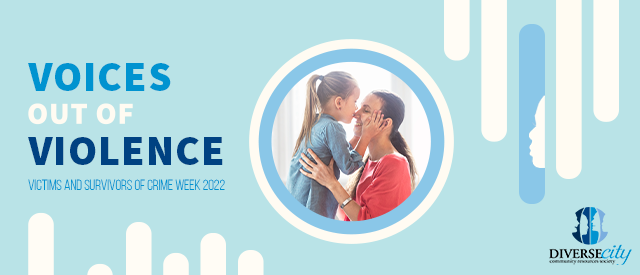Victims and Survivors of Crime Week (May 15–21, 2022):
Discussing issues facing diverse victims of crimes and culturally safe resources and safety planning available to them
By Daniela Cohen
Family violence against children and youth in Canada has been increasing each year since 2016. In 2019, Statistics Canada reported that one-third of the 69,691 children and youth victims of police-reported violence, 57 per cent girls, were victimized by a family member.
The impacts of family violence on children and youth include physical injury, delayed development, emotional and mental health issues, and risky behaviour such as alcohol and drug use, as well as increased risk of victimization in adulthood.
Despite the violence they face, it is difficult for children and youth to ask for help. That’s especially true for newcomer kids.
Asking for help isn’t easy
One of the main barriers newcomer children and youth experiencing violence in the home face in accessing support is their “fear of speaking out,” says Richa Karkee, Manager, Violence Prevention Services at DIVERSEcity.
“The [immigrant] family unit tends to be quite close,” she says. “You moved here as a family and it is your comfort zone in a new country, even if sometimes it might not be safe, especially in resettlement and settlement.”
Newcomer children and youth may also not understand their rights or the systems in Canada or even what constitutes violence or abuse at home. They may worry about the family unit breaking down and the ripple effects on family relationships outside of Canada. And despite the abuse they are experiencing, they have an attachment to their parent, who they depend on.
Mia, a counsellor with the PEACE program at DIVERSEcity, says that children and youth may come from cultures where violence is normalized. They may even share stories with newcomer friends at school. “That’s like trauma bonding,” says Mia, “but they don’t realize that what is happening among them is not OK.”
Language can be an additional barrier in accessing help. Even with an interpreter, important nuances can be missed due to different dialects. Sometimes, there are also no words in someone’s mother tongue to express certain feelings like one would in English.
When trying to understand if her 11-year-old Somali client, Muhibo (not real name) was thinking about suicide, for example, the indirect translation Mia had to give was, “Are you bringing your own doom?” This lack of nuanced language presents an even greater challenge with younger children.
Help is available
But there are places to turn for help. DIVERSEcity’s Prevention, Education, Advocacy, Counselling and Empowerment (PEACE) program for children and youth experiencing violence provides free, supportive, psycho-educational counselling for children and youth, aged three to 18, who have witnessed or experienced violence at home. It also offers support to children and youth who experienced violence in their resettlement journey. Currently, first language support is available in Punjabi and Arabic.
Programming is tailored to the child’s age, using games for children under 12 and activities involving talk therapy for older youth. Staff also work with the non-offending caregiver, providing them with parenting tools and connecting them with additional resources.
Cultural humility, safety and agility are key in providing support. “We try not to make assumptions,” Karkee says, “but we want to educate ourselves on cultural pieces and what’s important in terms of people’s values.”
The program uses multicultural resources rather than one generalized resource for everyone.
Most importantly, it provides a non-judgmental space to self regulate, which many children and youth lack, Mia says. For example, when a youth saw she could share something which nobody else understood, she finally felt heard and gained self-understanding, making a profound impact on her journey toward healing.
Resources to support children and youth who are experiencing violence
Kids Help Phone
Free at 1-800-668-6868 or text CONNECT to 686868. You don’t have to tell them your name.
DIVERSEcity’s PEACE program
Canadian Centre for Child Protection
Resources for eight to 10-year-olds, tweens and teens to promote safety online. Their Cypbertip.ca tip line can be used to report the online sexual exploitation of children.
Changeville
An interactive site providing age-appropriate information for youth whose parents are going through separation and divorce.
Justice Canada
General information on family violence and the law. A booklet for parents called Child Abuse is Wrong: What Should I Do? talks about child abuse in families and answers questions about the law on child abuse in Canada.
Children First Canada
The website provides information and resources for children and families impacted by COVID-19. The teachers’ toolkit can help educators communicate with children and youth who are at risk of family violence.
Public Health Agency of Canada – Stop Family Violence
A one-stop source for information on family violence.
Department of Justice Victim Services Directory
Helps service providers, victims and individuals locate services for victims of crime across Canada.
Child Welfare League of Canada
A list of COVID-19 resources for parents, youth and caregivers. It includes resources that have been developed by and for Indigenous people.
Jack.org
A COVID-19 Youth Mental Health Resource Hub to provide young people with mental health information and resources during the COVID-19 pandemic.

